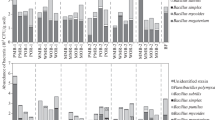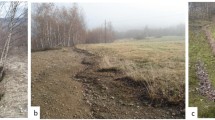Summary
Microfungal species composition was studied in coniferous forest soils which had been treated with lime or wood ash. The pH increased by about 2.5 units at the highest rate of application. Fungi were isolated 4–5 years after the treatments using a soil washing technique. At one site, Öringe, clear differences in species composition due to liming were found. Penicillium spinulosum, Oidiodendron cf. truncatum, Mortierella spp., and two sterile taxa decreased in abundance in limed areas, while Geomyces pannorum, Penicillium cf. brevicompactum, Trichoderma polysporum, and Trichosporiella sporotrichioides increased in isolation frequency. At another site, Torrmyra, the effect of liming was less pronounced, although the pH changes due to the treatments were larger compared to the Öringe site. However, T. polysporum increased, while a sterile taxon decreased in abundance in lime- and wood ash-treated plots. The changes in microfungal species composition after liming were similar to those found earlier in urea-treated soils, and opposite to those found in artifically acidified or ammonium nitrate-fertilized soils.
Similar content being viewed by others
References
Arnebrant K, Bååth E, Nordgren A (1987) Copper tolerence of microfungi isolated from polluted and unpolluted forest soil. Mycologia 79:890–895
Arnebrant K, Bååth E, Söderström B (1990) Changes in microfungal community structure after fertilization of Scots pine forest soil with ammonium nitrate or urea. Soil Biol Biochem 22:309–312
Bååth E (1981) Microfungi in a clear-cut pine forest soil in central Sweden Can J Bot 59:1331–1337
Bååth E (1988) A critical examination of the soil washing technique with special reference to the effect of the size of the soil particle. Can J Bot 66:1566–1569
Bååth E, Berg B, Lohm U, Lundgren B, Lundkvist H, Rosswall T, Söderström B, Wirén A (1980) Effects of experimental acidification and liming on soil organisms and decomposition in a Scots pine forest. Pedobiologia 10:85–100
Bååth E, Lundgren B, Söderström B (1984) Fungal populations in podzolic soil experimentally acidified to simulate acid rain. Microb Ecol 10:197–203
Couture M, Fortin JA, Dalpé Y (1983) Oidiodendron griseum Robak: An endophyte of ericoid mycorrhiza in Vaccinium spp. New Phytol 95:375–380
Dalpé Y (1986) Axenic synthesis of ericoid mycorrhiza in Vaccinium angustifolium Ait. by Oidiodendron species. New Phytol 103:391–396
Erland S, Söderström B (1991) Effects of lime and ash treatments on ectomycorrhizal infection of Pinus sylvestris L. seedlings planted in a pine forest. Scand J For Res 6:519–525
Falkengren-Grerup U (1986) Soil acidification and vegetation changes in deciduous forest in southern Sweden. Oecologia 70:339–347
Falkengren-Greup U (1987) Long-term changes in pH of forest soils in southern Sweden. Environ Pollut 43:79–90
Hallbäcken L, Tamm CO (1986) Changes in soil acidity from 1927 to 1982–1984 in a forest area of south-west Sweden. Scand J For Res 1:219–232
Martens H, Naes T (1989) Multivariate calibration. John Wiley, New York
Nodar R, Acea MJ, Carballas T (1992) Microbiological response to Ca(OH)2 treatments in a forest soil. FEMS Microbiol Ecol 86:213–219
Nômmik H, Möller G (1981) Nitrogen recovery in soil and needle biomass after fertilization of a Scots pine stand, and growth responses obtained. Stud For Suec no. 159. Swed Univ Agric Sci, Uppsala
Nykvist N, Rosén (1985) Effect of clear-felling and slash removal on the acidity of northern coniferous soils. For Ecol Manage 11:157–169
Nordgren A, Bååth E, Söderström B (1985) Soil microfungi in an area polluted by heavy metals. Can J Bot 63:448–455
Persson T, Lundkvist H, Wirén A, Hyvōnen R, Wessén B (1989) Effects of acidification and liming on carbon and nitrogen mineralization and soil organisms in mor humus. Water Air Soil Pollut 45:77–96
Söderström B, Bååth E (1978) Soil microfungi in three Swedish coniferous forests. Holarc Ecol 1:62–72
Tamm CO, Hallbäcken L (1988) Changes in soil acidity in two forest areas with different acid deposition: 1920s to 1980s. Ambio 17:56–61
Zelles L, Stepper K, Zsolnay A (1990) The effect of line on microbial activity in spruce (Picea abies L.) forests. Biol Fertil Soils 9:78–82
Author information
Authors and Affiliations
Rights and permissions
About this article
Cite this article
Bååth, E., Arnebrant, K. Microfungi in coniferous forest soils treated with lime or wood ash. Biol Fertil Soils 15, 91–95 (1993). https://doi.org/10.1007/BF00336424
Received:
Issue Date:
DOI: https://doi.org/10.1007/BF00336424




